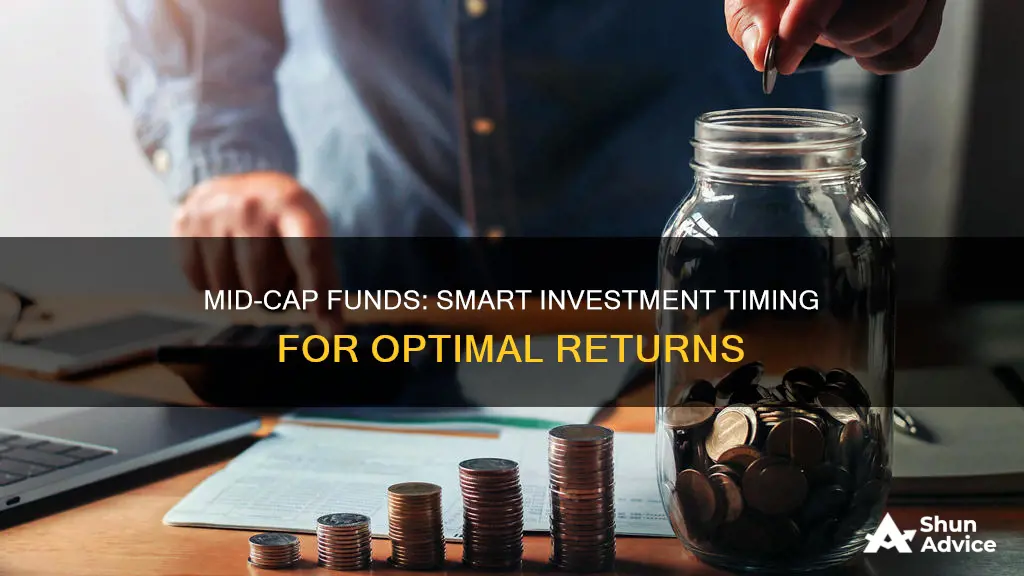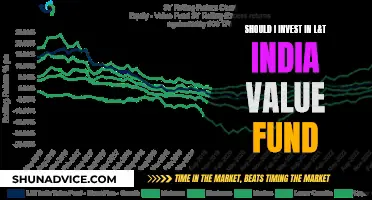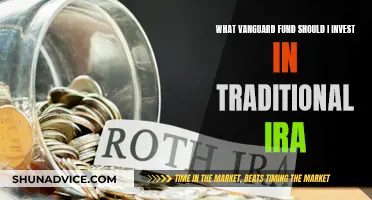
Mid-cap funds are a type of investment vehicle that focuses on companies with a market capitalization in the range of $2 billion to $10 billion. These funds offer investors the potential for growth and diversification, as they are often overlooked by the broader market. While mid-cap stocks may be riskier than large-cap stocks, they can provide higher returns over the long term. Additionally, mid-cap companies have already navigated the high-risk phases associated with startups and early market development, which translates to a lower level of investment risk for investors. When considering investing in mid-cap funds, it is important to assess your risk tolerance, investment horizon, and overall financial goals.
| Characteristics | Values |
|---|---|
| Company size | $2 billion to $10 billion in market capitalization |
| Risk | Less risk than small-cap stocks due to being more established |
| Returns | Higher absolute returns over a longer time frame |
| Volatility | More volatile than large-cap stocks |
| Growth | Better growth opportunities than large-cap stocks |
| Performance | Outperform small- and large-cap stocks over a long time horizon |
| Diversification | Balances growth and stability |
| Investment duration | Not suitable for short-term investments |
What You'll Learn

Mid-caps vs. small- and large-cap stocks
Mid-cap, small-cap, and large-cap stocks differ in terms of market capitalization, volatility, and growth potential.
Market Capitalization
The market capitalization of a company, or market cap, is calculated by multiplying the total number of a company's shares by the current market price of one share. Mid-cap companies typically have a market capitalization between $2 billion and $10 billion. Small-cap companies have a market capitalization between $250 million and $2 billion, while large-cap companies have a market capitalization of $10 billion or more.
Volatility and Risk
Large-cap stocks tend to be less volatile and are considered more stable investments. This is because they are typically well-established, mature companies with strong market presence and greater liquidity. Mid-cap stocks have moderate volatility and liquidity, while small-cap stocks are more volatile and have less liquidity.
Growth Potential
Small-cap stocks have greater growth potential than mid-cap and large-cap stocks. This is because it is easier for smaller companies to generate proportionately large growth rates. However, small-cap stocks also come with higher risk. Mid-cap stocks offer a balance between growth and stability, making them attractive for portfolio diversification.
Investor Profile
The suitability of investing in mid-cap, small-cap, or large-cap stocks depends on an investor's risk tolerance and investment horizon. Conservative investors seeking long-term returns may prefer large-cap stocks due to their lower risk profile and stable returns. Mid-cap stocks are suitable for investors with a moderate risk appetite and a long-term investment horizon. Small-cap stocks are best for short-term investors with a high-risk tolerance and a strong capacity for research.
Vanguard Funds: Minimum Investment Requirements and Options
You may want to see also

Risk and volatility
Mid-cap stocks are a risky investment option, and investors need to be able to stomach the volatility involved. Mid-cap stocks are more volatile than large-cap stocks, and their underlying businesses can go through sharp ups and downs with changing economic scenarios. During boom times, they perform well, but during bust times, they crash.
However, mid-cap stocks have historically generated higher absolute returns over longer time frames and have provided these returns with less associated risk than small-cap stocks. Over a 20-year period ending in 2023, investors in mid-caps experienced higher returns and lower risk relative to investors in small-caps.
Mid-cap stocks are also less risky than small-cap stocks because the businesses are more established, and the risks associated with early growth are lessened. Mid-cap companies have navigated the high-risk phases associated with startups and early market development, which can mean a lower level of investment risk and a proven level of staying power.
Additionally, active management can help in controlling risk. Active management may have an advantage when stock correlations are low across the market, and more assets are invested in passive index funds and ETFs. Stocks that are not in an index may fly under the radar, providing opportunities for active managers to buy those stocks at a good value relative to the market.
The mid-cap market offers more established business models, more established management teams, and a little less risk than small-cap stocks. However, investors should be absolutely certain of the quality and business strength of mid-cap companies before investing.
Best Funds to Maximize Your 401k Returns
You may want to see also

When to buy and sell
When to Buy Mid-Cap Funds:
- Long-Term Investment Horizon: Mid-cap funds are suitable for investors with a long-term investment horizon, typically at least five years. This allows your portfolio to weather market volatility and increase the potential for robust returns.
- Risk Appetite: Mid-cap funds are generally riskier than large-cap funds but offer higher return potential. Consider your risk appetite before investing. If you are comfortable with taking on more risk, mid-cap funds can provide attractive returns.
- Diversification: Mid-cap funds can add diversification to your portfolio. They offer a balance of growth and stability, providing exposure to well-established companies with strong growth trajectories.
- Fundamentals: Research the fundamentals of the mid-cap companies in the fund, including their operating performance, valuation, and market sentiment. Look for companies with strong management teams, established business models, and growth opportunities.
- Market Conditions: Consider investing in mid-cap funds when the market is bearish and valuation spreads are wide. These environments can present significant opportunities for long-term wealth creation.
- Active Management: Opt for actively managed mid-cap funds, especially in a low-stock correlation market environment with a high proportion of passive index fund investments. Active management can help control risk and identify stocks that fly under the radar.
When to Sell Mid-Cap Funds:
- Fund Performance: If the mid-cap fund has been consistently underperforming its benchmark or category for an extended period, typically two years or more, it may be time to consider selling.
- Investment Goals: If you are nearing your investment goals, such as a target amount or a specific financial objective, you may want to exit the mid-cap fund and reallocate your portfolio accordingly.
- Fund Misalignment: If you realise that you have invested in the wrong fund, and it no longer aligns with your investment strategy, risk appetite, or financial goals, consider exiting the fund.
- Fundamentals Deterioration: Monitor the fundamentals of the underlying mid-cap companies. If their business fundamentals deteriorate, or their valuations become stretched, it may be prudent to sell the fund and look for better opportunities.
- Better Opportunities: If you identify more attractive investment opportunities elsewhere, whether in other mid-cap funds or different asset classes, you may consider selling the fund to reallocate your capital.
Remember, the decision to buy or sell mid-cap funds should be based on a comprehensive assessment of your financial situation, investment goals, risk tolerance, and market conditions. It is always advisable to consult with a financial advisor to determine the most suitable investment strategies for your specific circumstances.
Index Funds: Best Time to Invest and Maximize Returns
You may want to see also

Active vs. passive fund management
Mid-cap companies are those with a market capitalization of $2 billion to $10 billion. They can be an attractive investment opportunity as they have already navigated the high-risk phases associated with startups and early market development. This means a lower level of investment risk and proven staying power. Mid-cap stocks have also historically outperformed small- and large-cap stocks over longer periods of time.
When considering investing in mid-cap funds, or any other type of fund, it is important to understand the differences between active and passive fund management.
Active fund management involves a fund manager actively selecting stocks, bonds, and other holdings for a portfolio, with the goal of outperforming the market. Active managers can use their skills and expertise to identify investments that may be undervalued or have strong growth potential. Active funds often come with higher fees due to the extensive research and analysis required.
Passive fund management, on the other hand, aims to duplicate market returns rather than trying to beat them. Passive funds, also known as index funds, buy and hold the stocks or bonds in a market index such as the S&P 500. These funds have very low fees since there is no need to actively analyze securities, and they offer good transparency as investors know what stocks or bonds the fund contains.
In recent years, passive investing has become a popular strategy for investors who are satisfied with matching market returns. Over the past decade, passive funds have attracted more inflows than active funds as investors seek out cost-effective and broad market exposure. However, active fund management still has its advantages and can play an important role in a diverse portfolio.
Active management offers flexibility as managers are not required to hold specific stocks or bonds. It also allows for hedging strategies such as short sales and put options to insure against losses. Additionally, active managers can use risk management techniques to get out of specific holdings or market sectors when risks become too large. Tax management strategies can also be tailored to individual investors.
The choice between active and passive fund management depends on various factors, including an investor's risk appetite, the type of investments, and access to top-quality advisers. While passive investing has been popular recently, active management has historically outperformed during market corrections and can help mitigate risk by reducing exposure to expensive areas.
When deciding whether to invest in mid-cap funds, investors should consider both active and passive fund management strategies. Active management may be more suitable for those seeking higher returns and willing to take on more risk, while passive management may be preferred by those looking for low-cost, broad market exposure. Ultimately, a combination of both approaches may be the best strategy, depending on an investor's goals and risk tolerance.
The Mindset of Investment Fund Managers: Traits and Insights
You may want to see also

Advantages of mid-cap funds
Mid-cap funds offer a balance of growth and stability, making them an attractive option for investors seeking diversification and optimal returns. Here are some advantages of investing in mid-cap funds:
Growth Potential and Stability
Mid-cap companies, typically with a market capitalization between $2 billion and $10 billion, have already navigated the high-risk phases associated with startups. They offer investors the opportunity for growth in well-known companies with established business models and management teams. While they may not have the same allure as small-cap stocks, mid-cap stocks provide more stability and less risk.
Long-Term Performance
Historically, mid-cap stocks have outperformed small- and large-cap stocks over longer periods. Between 2003 and 2023, mid-caps outperformed 60% of the time with less associated risk. This trend is expected to continue, with JP Morgan anticipating strong returns for U.S. mid-cap stocks over a 10-to-15-year investment horizon.
Lower Volatility and Risk-Adjusted Performance
Mid-cap stocks have generated higher absolute returns over longer periods while exhibiting lower volatility compared to small-cap stocks. Additionally, while mid-caps may carry more risk than large-caps, investors are rewarded with higher returns. This combination of higher returns and lower risk makes mid-cap stocks attractive for those seeking better risk-adjusted performance.
Diversification and Portfolio Optimization
Mid-cap stocks are an excellent tool for portfolio diversification. They provide a balance of growth and stability, helping to optimize returns while managing risk. By investing in mid-cap funds, you can gain exposure to a diverse range of companies across sectors, reducing the impact of individual stock volatility on your portfolio.
Profitability and Resilience
Mid-cap companies have demonstrated profitability potential, particularly in consumer discretionary, energy, and industrials sectors. They tend to have resilient business models and are less reliant on capital markets to fund their growth, making them attractive investment opportunities, especially in times of high capital costs.
Active Management Advantage
Active management can be beneficial in the mid-cap space. As stock correlations decrease and passive investments increase, active managers can identify and capitalize on opportunities that may be overlooked by passive strategies. This advantage can help control risk and enhance returns for investors.
In summary, mid-cap funds offer a compelling combination of growth potential, stability, long-term performance, and diversification. They are particularly well-suited for investors with a medium to high-risk appetite and a long-term investment horizon who are seeking to optimize their portfolios and capitalize on the expertise of fund managers.
Hedge Funds vs Investment Banks: Understanding the Key Differences
You may want to see also
Frequently asked questions
Mid-cap funds are mutual funds that invest in companies with a market capitalisation of around $2 billion to $10 billion. These companies are more established than small-cap companies but may offer more growth opportunities than large-cap companies.
Mid-cap funds can provide a balance of growth and stability in an investor's portfolio. They can also be a good option for investors with a medium to high-risk appetite, as they invest in both safer large-cap stocks and riskier, high-return mid-cap stocks. Additionally, mid-cap funds can be a good way to diversify across the two major categories of the stock market.
As with any stock market investment, there is inherent volatility and uncertainty in mid-cap funds. A short investment duration may not be sufficient for a mid-cap fund portfolio to overcome volatility and provide robust returns. Additionally, a wrong call from the fund manager could lead to losses.







